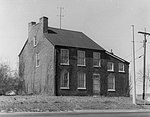New Castle County, Delaware

New Castle County is the northernmost of the three counties of the U.S. state of Delaware (New Castle, Kent, and Sussex). As of the 2020 census, the population was 570,719, making it the most populous county in Delaware, with nearly 60% of the state's population of 989,948. The county seat is Wilmington, which is also the state's most populous city. New Castle County is included in the Philadelphia-Camden-Wilmington, PA-NJ-DE-MD Metropolitan Statistical Area. The county is named after William Cavendish, 1st Duke of Newcastle (c. 1593–1676). New Castle County has the highest population and population density of any Delaware county, and it is the smallest county in the state by area. It has more people than the other two counties, Kent and Sussex, combined. It is also the most economically developed of the three.
Excerpt from the Wikipedia article New Castle County, Delaware (License: CC BY-SA 3.0, Authors, Images).New Castle County, Delaware
Wrangle Hill Road,
Geographical coordinates (GPS) Address Nearby Places Show on map
Geographical coordinates (GPS)
| Latitude | Longitude |
|---|---|
| N 39.58 ° | E -75.64 ° |
Address
Wrangle Hill Road 200
19720
Delaware, United States
Open on Google Maps










